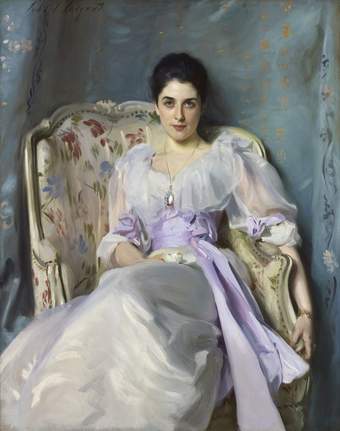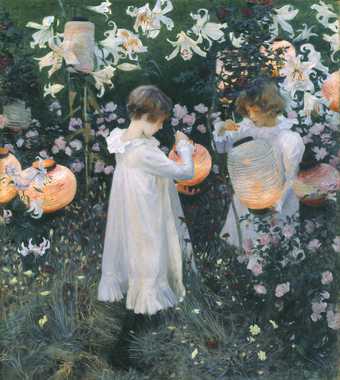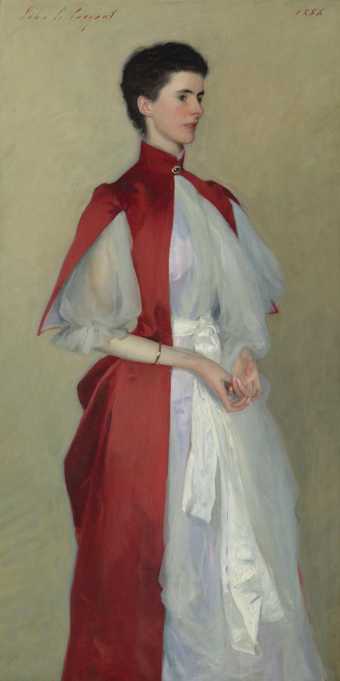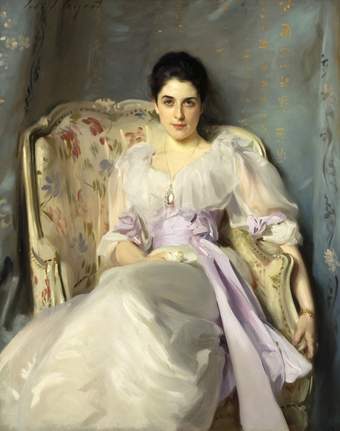
Sargent and Fashion
Find out more about our exhibition at Tate Britain

Fashion was central to John Singer Sargent’s (1856–1925) achievements as a portraitist. In a career which coincided with the rise of haute couture, Sargent painted portraits which embraced the creative potential of clothing and costume. In this exhibition, Sargent’s work is displayed alongside examples of period fashion, including several original garments depicted in his paintings.
An international artist, Sargent was born in Italy to North American parents. He lived in several European countries as a child, before forging his artistic reputation in Paris. In 1886 he settled in London, although he continued to travel widely, and worked extensively in the US. Sargent embodied the cosmopolitan values of 19th-century high society, to which many of his sitters belonged.
In late 19th-century society circles, luxury clothing was highly coded. North American writer and designer Edith Wharton described it in her novel The Age of Innocence as functioning like ‘armour’ in its ability to bestow social advantage. Similarly, portraits created a lasting public image of an individual. The sartorial choices involved in this process could make – or break – a sitter’s reputation.
Sargent’s portraits operated in the space between the desires of his sitters and his own artistic ideals. This was a space of collaboration and sometimes of tension, revealing the distinct experiences and personalities of his sitters. This dynamic gives his portraiture its extraordinary life, which speaks to us across the decades.
1. Introduction
John Singer Sargent not only painted his sitters – he directed and styled them as well. He may have claimed that ‘I only paint what I see’, but what he saw was itself carefully constructed. Not content with simply documenting the fashions of the day, Sargent used them as a catalyst to create compelling paintings. Rather than painting clothes as worn, Sargent carefully manipulated them for pictorial effect. He pinned, draped, tucked and folded his sitters’ garments to create new shapes and textures. One sitter recalled the painful experience of Sargent arranging draperies using pins ‘which often pricked’.
This transformation is evident when comparing the portrait of Lady Sassoon with the opera cloak she wears, both on display here. Sargent manipulated the cloak, wrapping it around Lady Sassoon to foreground the play of light on the fabric. The bright pink lining of the cloak, barely noticeable in real life, creates a sinuous diagonal streak which guides the viewer’s eye across the surface of the portrait.
2. WOMEN IN BLACK
Black dresses became fashionable for women of all ages during the late 19th century. While black clothing retained its association with mourning during this period, codes of etiquette relaxed to make it wearable in a range of contexts. This shift is reflected by the prevalence of black in Sargent’s portraiture. During the 1880s, in fact, he painted almost half his female sitters, of different ages, wearing black gowns. Some of these works are on display here.
The contemporary vogue for black clothing enabled Sargent to create portraits that were both modern and in dialogue with this tradition. The introduction of aniline (synthetic) dyes in the mid-19th century resulted in an intense pure black, patented in 1863, that enabled a new depth of colour. Sargent’s heroes, meanwhile, included two 17th century masters of black: Spanish painter Diego Velázquez and Dutch artist Frans Hals. Indeed, the colour was so integral to his work that, when visiting his friend, French artist Claude Monet, Sargent was unable to work upon learning that Monet did not have any black paint.
THE SALON OF 1884
Sargent’s portrait of Virginie Gautreau was first exhibited in 1884 at the Salon, held at the Palais des Champs-Élysées in Paris.
The painting originally showed one of the jewelled straps of the sitter’s dress slipping off her shoulder, as can be seen in the photograph nearby. Sargent insisted he painted Gautreau ‘exactly as she was dressed’, and Gautreau herself described the portrait as a masterpiece in a letter to a friend. Nonetheless, at the Salon the painting was ridiculed by both critics and the public, and many commentators denounced the ‘indecency’ of the dress as a bid for attention. Gautreau’s own mother lamented the cost to her daughter’s reputation. The strap was subsequently repainted and Sargent left Paris soon afterwards, his own reputation also somewhat damaged.
The portrait can also be seen as a daring intervention into the conventions of Parisian society by two ambitious figures of North American origin. Sargent kept the portrait until after Gautreau’s death in 1915, when he sold it to the Metropolitan Museum of Art in New York. In a letter to the institution’s director, Sargent wrote ‘I suppose it is the best thing I have done’.

John Singer Sargent Madame X (Madame Pierre Gautreau) 1883–1884 Lent by The Metropolitan Museum of Art, Arthur Hoppock Hearn Fund, 1916 (16.53)
3. SITTING FOR SARGENT
Many of Sargent’s sitters were involved with the visual arts as collectors, gallerists or practitioners. A number documented their experience of sitting for him, aware of the significance of the event and their role as collaborators. Sargent himself was scrupulously private, but his sitters left numerous accounts of what it was like to sit for him.
Sargent and his sitters thought carefully about the clothes that he would paint them in, the messages their choices would send, and how well particular outfits would translate to paint. The rapport between fashion and painting was well understood at this time: as one French critic noted, ‘there is now a class who dress after pictures, and when they buy a gown ask ‘will it paint?’’
After settling in England in the 1880s, most of Sargent’s portraits were painted in his London studio. The paintings in this room, however, were made in a range of spaces in Britain and the United States, where demand for his work was also substantial.
THE HOUSE OF WORTH
Charles Frederick Worth (1825–1895) was a designer who dominated Parisian fashion in the second half of the 19th century. Born in Lincolnshire, England, he moved to Paris following an apprenticeship in London. He set up his fashion house in 1858, initially with Swedish businessman Otto Gustav Bobergh, and quickly built up a prestigious clientele including queens and princesses. By the 1870s Worth employed over 1,000 people, and by the late 1880s he had established many of the traits associated with the modern couture house. These included presentations of seasonal collections, the display of new lines on living models, and the branding of exclusive designs with the couturier’s name.
Worth’s most successful years coincided with the height of Sargent’s career as a portraitist. Like Sargent, Worth increasingly catered to British and American customers, and many of Sargent’s sitters wore outfits from the designer.
Worth cultivated the image of the couturier as artist, saying ‘I have Delacroix’s sense of colour and I compose. A toilette [a complete ensemble, from the French word toile, cloth] is as good as a painting’.
4. ‘WONDERFUL POSSIBILITIES’
Fixed ideas of masculinity and femininity exerted a strong influence on the society in which Sargent worked. He conformed to these expectations in commissioned portraits such as that of the Harvard benefactor Henry Lee Higginson, who appears as the epitome of virile manliness. In his more personal works, however, Sargent was drawn to sitters who used clothing to subvert these conventions, and embraced the expressive possibilities of clothing. Male sitters were depicted in traditionally feminine spaces or in unconventional clothing. Women in his paintings often wore clothes associated with men, either as playful masquerade or as wholesale rejection of gender conventions, such as Vernon Lee, on display here.
Another sitter, Graham Robertson, recalled of his experience sitting for Sargent that ‘it was a pity that Oscar Wilde opposite was not looking out of the window: the “wonderful possibilities of Tite Street” were yet unexhausted’. Wilde, one of Sargent’s neighbours in London, had previously used this phrase to link Sargent’s work with the artistic milieu they shared.
5. PERFORMANCE
Portraits are performances, negotiated between sitter and artist. Outfits are selected, poses devised, and the outcome observed by an audience. Some of Sargent’s sitters, such as Ellen Terry and Carmencita, were professional performers who appealed to Sargent’s love of music and theatre. Others, such as Lord Ribblesdale, were society personalities who paid fastidious attention to their daily comportment – the performance of everyday life.
In Sargent’s time, dressing up in clothing other than one’s usual attire was not limited to professional actors on stage. It was also a popular form of entertainment in costume balls, masquerades and amateur theatre. Inspiration came from art, history, mythology, folk traditions, and Asian and North African cultures. While Sargent was concerned with the painterly possibilities of clothing, paintings such as the portrait of Almina Wertheimer invite consideration of what it means to wear the dress of a culture that is not your own. This gallery includes portraits of people dressing up – both onstage and off – within their own traditions, as well as sitters wearing clothes from other cultures. Each presents a different, often complicated, story about identity.
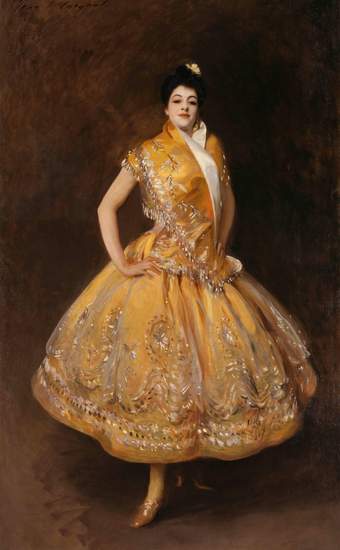
John Singer Sargent La Carmencita circa 1890 Musée d'Orsay (Paris, France)
THE 1889 PARIS EXPOSITION
Sargent’s painting Javanese Dancer, displayed on the far right of this wall, was inspired by his visit to the 1889 Exposition Universelle – a world’s fair held in Paris. Over 32 million visitors attended. Like other ‘universal exhibitions’ of this type, it represented culture from around the world through a colonial lens. Writer Edward Said described these exhibitions as events in which cultures ‘were exhibited before Westerners as microcosms of the larger imperial domain’.
The ‘Exposition des Colonies’, representing the cultures of colonised peoples, was held on a site separate from the majority of the exhibition. One of the most popular elements was situated here – the kampong javanais. This was an enclosed recreation of a village from the island of Java in Indonesia, then under Dutch colonial rule. 60 people were brought from Java to participate in the exhibition including four young dancers from the Mangkunegaran court: Seriem, Soekia, Taminah and Wakiem, aged 12 to 16 years old. They performed an episode from the Javanese epic Damarwulan.
Sargent and several other artists, writers and musicians were inspired by their experience of visiting the kampong. Sargent produced a number of sketches and paintings of the dancers whose performances he witnessed.
TITE STREET
After moving from Paris to London in 1886, Sargent became part of an aesthetic and artistic circle that included actors, composers, writers and artists. His studio at 31–33 Tite Street in Chelsea had formerly been occupied by the painter James Abbott McNeill Whistler. Sargent’s portrait of the actress Ellen Terry, on display here, encapsulates this creative milieu. Among Sargent’s neighbours was the writer Oscar Wilde, who lived opposite Sargent at number 34. Wilde celebrated the unique character of Tite Street after Sargent painted Ellen Terry: ‘The street that on a wet and dreary morning has vouchsafed the vision of Lady Macbeth in full regalia magnificently seated in a four-wheeler can never again be as other streets: it must always be full of wonderful possibilities.’
6. CUTTING A FIGURE
Clothing can convey status and authority. This is true of military uniforms and robes of state, but it can also be said of designer gowns. Then, as now, sartorial choices at social events were carefully scrutinised and viewed as a reflection of one’s social standing. Some of the figures in this room, like Lord Londonderry, came into hereditary titles. Others cultivated social, cultural or political status.
Compelling portraits attracted large crowds, were widely discussed, and frequently reproduced. This in turn accrued social status for those portrayed. Sargent’s work was much in demand from sitters seeking an authoritative image of themselves. It is a measure of Sargent’s achievement that, while the lives of many of his sitters are little-known today, his images of them endure.
7. ‘THE VAN DYCK OF OUR TIME’
Sargent’s career in Britain coincided with a revival of interest in historic portraitists such as Joshua Reynolds and Thomas Gainsborough, and Sargent adapted his style to resemble the opulence of the ‘grand manner’ portraiture they exemplified. The sculptor Auguste Rodin described Sargent as ‘the Van Dyck of our time’, referencing the 17th-century Flemish artist who became the leading painter of the British court.
Compared with these artists, however, Sargent painted relatively few members of the British aristocracy. His clientele was international, and many of his sitters derived their income from finance, commerce, the arts, or the sciences. During a time of uncertainty for the British aristocracy due to social change and the rise of new sources of wealth, Sargent’s work was sought-after by a diverse clientele. A portrait by Sargent might serve as a reassuring symbol of a historic lineage, or announce the arrival of more recently wealthy people into the upper echelons of a changing society.
8. OUTSIDE FASHION
Throughout his career, alongside the formal portraiture for which he is most celebrated, Sargent produced another kind of painting. In these works, figures are situated in landscapes and are not identified by name, pointedly distinguishing them from portraits. Here, in seemingly casual but meticulously arranged compositions, Sargent experimented with fabric and texture in ways not possible within the strictures of society portraiture. He explored light and shadow, using long, broad strokes of thick paint for a highlight, or shorter, drier touches to capture the sparkle of sunlight.
Sargent travelled extensively during the summer months, and made many paintings of his ‘intertwingles’ – as he called the travelling companions he depicted in various configurations. In these works he luxuriates in an abundance of both fabric and paint, transforming garments into imaginary landscapes made from whole pieces of cloth. The figures in these paintings are nonchalant or occupied, allowing the clothing to take centre stage.
9. POSTSCRIPT
By 1907 Sargent had effectively stopped painting commissioned portraits. Much of his later career was dedicated to large-scale mural projects in Boston, for the Public Library and Museum of Fine Arts. He also served as a war artist during the First World War, when he made his largest oil paintings. Fashion was changing too. From the 1920s, the widespread availability of ready-to-wear clothing for women offered wider access to fashionable clothing, as well as less-fitted styles than those painted by Sargent.
Sargent still occasionally painted portraits, usually of his friends. He was particularly close to the Sassoon family, several of whom he painted over an extended period. Sargent’s final portraits are those of an artist with nothing left to prove. His late portrait of Sybil Sassoon is an expression of the intimacy and affection developed over many years between artist and sitter.
Need a bigger font size of the exhibition guide? Download the large print guide [3.6MB]

